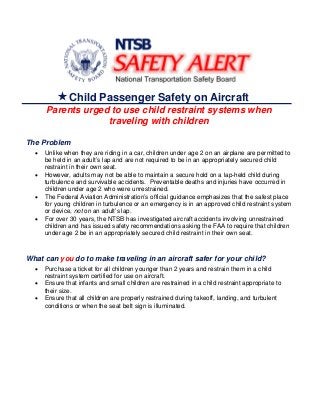
Child passenger safety on aircraft
- 1. Child Passenger Safety on Aircraft Parents urged to use child restraint systems when traveling with children The Problem • Unlike when they are riding in a car, children under age 2 on an airplane are permitted to be held in an adult’s lap and are not required to be in an appropriately secured child restraint in their own seat. • However, adults may not be able to maintain a secure hold on a lap-held child during turbulence and survivable accidents. Preventable deaths and injuries have occurred in children under age 2 who were unrestrained. • The Federal Aviation Administration’s official guidance emphasizes that the safest place for young children in turbulence or an emergency is in an approved child restraint system or device, not on an adult’s lap. • For over 30 years, the NTSB has investigated aircraft accidents involving unrestrained children and has issued safety recommendations asking the FAA to require that children under age 2 be in an appropriately secured child restraint in their own seat. What can you do to make traveling in an aircraft safer for your child? • Purchase a ticket for all children younger than 2 years and restrain them in a child restraint system certified for use on aircraft. • Ensure that infants and small children are restrained in a child restraint appropriate to their size. • Ensure that all children are properly restrained during takeoff, landing, and turbulent conditions or when the seat belt sign is illuminated.
- 2. SA-015 May 2010 Need more information? • A brief description of this issue and the NTSB’s first recommendation to require child restraint systems on aircraft can be found at: http://www.ntsb.gov/Recs/letters/1990/A90_78_79.pdf • American Academy of Pediatrics (AAP) o AAP Policy on Restraint Use on Aircraft: http://aappolicy.aappublications.org/cgi/content/full/pediatrics;108/5/1218 • FAA o Child Safety on Airplanes: www.faa.gov/passengers/fly_children/crs/ o Childproof your flight: www.faa.gov/passengers/media/childsafety.pdf
